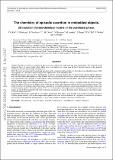Files in this item
The chemistry of episodic accretion in embedded objects : 2D radiation thermo-chemical models of the post-burst phase
Item metadata
| dc.contributor.author | Rab, Ch. | |
| dc.contributor.author | Elbakyan, V. | |
| dc.contributor.author | Vorobyov, E. | |
| dc.contributor.author | Güdel, M. | |
| dc.contributor.author | Dionatos, O. | |
| dc.contributor.author | Audard, M. | |
| dc.contributor.author | Kamp, I. | |
| dc.contributor.author | Thi, W.-f. | |
| dc.contributor.author | Woitke, P. | |
| dc.contributor.author | Postel, A. | |
| dc.date.accessioned | 2018-11-01T12:30:08Z | |
| dc.date.available | 2018-11-01T12:30:08Z | |
| dc.date.issued | 2017-08 | |
| dc.identifier | 256418418 | |
| dc.identifier | 5f31b5ce-e205-4092-9187-0105008cc417 | |
| dc.identifier | 85026382928 | |
| dc.identifier | 000408480100112 | |
| dc.identifier.citation | Rab , C , Elbakyan , V , Vorobyov , E , Güdel , M , Dionatos , O , Audard , M , Kamp , I , Thi , W , Woitke , P & Postel , A 2017 , ' The chemistry of episodic accretion in embedded objects : 2D radiation thermo-chemical models of the post-burst phase ' , Astronomy & Astrophysics , vol. 604 , A15 . https://doi.org/10.1051/0004-6361/201730812 | en |
| dc.identifier.issn | 0004-6361 | |
| dc.identifier.other | crossref: 10.1051/0004-6361/201730812 | |
| dc.identifier.uri | https://hdl.handle.net/10023/16370 | |
| dc.description | RCH and EV acknowledge funding by the Austrian Science Fund (FWF): project number I2549-N27. RCH and MG acknowledge funding by the Austrian Science Fund (FWF): project number P24790.MAand AP acknowledge funding by the Swiss National Science Foundation (SNSF): project number: 200021L_163172. The research leading to these results has received funding from the European Union Seventh Framework Programme FP7-2011 under grant agreement no 284405. This publication was partly supported from the FFG ASAP 12 project JetPro* (FFG-854025). This publication was supported by the Austrian Science Fund (FWF). The computational results presented have been achieved using the Vienna Scientific Cluster (VSC). | en |
| dc.description.abstract | Context. Episodic accretion is an important process in the evolution of young stars and their environment. The observed strong luminosity bursts of young stellar objects likely have a long lasting (i.e. longer than the burst duration) impact on the chemical evolution of the disk and envelope of young stars. Aims. We aim to investigate the observational signatures of the chemical evolution in the post-burst phase for embedded sources. With such signatures it is possible to identify targets that experienced a recent luminosity burst. Methods. We present a new model for the chemistry of episodic accretion based on the two dimensional, radiation thermo-chemical disk code PRODIMO (PROtoplanetary DIsk MOdel). We have extended PRODIMO with a proper treatment for envelope structures. For a representative Class I model, we calculated the chemical abundances in the post-burst phase and produced synthetic observables such as intensity maps and radial intensity profiles. Results. During a burst, many chemical species, such as CO, sublimate from the dust surfaces. As the burst ends they freeze out again (post-burst phase). This freeze-out happens from inside-out due to the radial density gradient in the disk and envelope structure. This inside-out freeze-out produces clear observational signatures in spectral line emission, such as rings and distinct features in the slope of radial intensity profiles. We fitted synthetic C18O J = 2−1 observations with single and two component fits and find that post-burst images are much better matched by the latter. Comparing the quality of such fits therefore allows identification of post-burst targets in a model-independent way. Conclusions. Our models confirm that it is possible to identify post-burst objects from spatially resolved CO observations. However, to derive proper statistics, such as the strength and frequencies of bursts, from observations it is important to consider the inclination and structure of the target and dust properties, as these have a significant impact on the freeze-out timescale. | |
| dc.format.extent | 25 | |
| dc.format.extent | 8877577 | |
| dc.language.iso | eng | |
| dc.relation.ispartof | Astronomy & Astrophysics | en |
| dc.subject | Stars: protostars | en |
| dc.subject | Stars: low-mass | en |
| dc.subject | Accretion, accretion disks | en |
| dc.subject | Astrochemistry | en |
| dc.subject | Methods: numerical | en |
| dc.subject | QB Astronomy | en |
| dc.subject | 3rd-DAS | en |
| dc.subject.lcc | QB | en |
| dc.title | The chemistry of episodic accretion in embedded objects : 2D radiation thermo-chemical models of the post-burst phase | en |
| dc.type | Journal article | en |
| dc.contributor.sponsor | European Commission | en |
| dc.contributor.institution | University of St Andrews. School of Physics and Astronomy | en |
| dc.contributor.institution | University of St Andrews. St Andrews Centre for Exoplanet Science | en |
| dc.identifier.doi | 10.1051/0004-6361/201730812 | |
| dc.description.status | Peer reviewed | en |
| dc.identifier.url | https://arxiv.org/abs/1705.03946 | en |
| dc.identifier.grantnumber | 284405 | en |
This item appears in the following Collection(s)
Items in the St Andrews Research Repository are protected by copyright, with all rights reserved, unless otherwise indicated.

